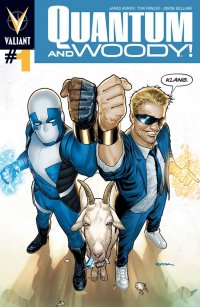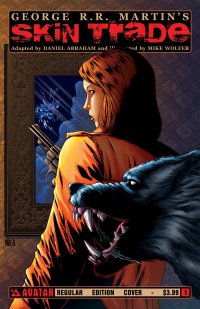A day late, and several contributors short, but Adam and Dan solider (er, Viking) on!
Quantum & Woody #1 ($3.99, Valiant)
by D.S. Randlett
Sometimes fiascos turn up gold. In this current epoch, the New 52 has given us a lot of bad stuff, and some pretty tone deaf reimaginings of certain characters. But then you’ve got stuff like Lemire and Sorrentino’s Green Arrow or Azzarello’s Wonder Woman, and you think, “We’ll, at least I’ve got this much.” In the nineties, Valiant Comics started to struggle after the bust of the speculation bubble and was subsequently purchased by the then titan of video games, Acclaim Entertainment, and redubbed Acclaim Comics. The Valiant mainstays were subsequently relaunched, and absolutely ruined. The most egregious example was in the handling of Turok, which utterly jettisoned everything that was compelling about that concept, replacing a great and somewhat tragic character (seriously, the Truman/Morales material really holds up) with an anemic college kid superhero trope. The entire line was pretty much that bad. But at least we had the legendary Christopher Priest and Mark Bright putting out the hilarious Quantum & Woody.
The premise of Quantum & Woody was essentially a riff on The Defiant Ones. After a freak accident (imagine that) the two old, but estranged, friends acquired superpowers that came with the cost of needing to touch the metal gauntlets they wear every twenty four hours. If they don’t, their atoms disperse, and they die. Of course, they were never as suave or as cool as Sidney Poitier and Tony Curtis, but they never needed to be. Being cool wasn’t the point. What made the original run of Quantum & Woody so vital at the time is that Priest and Bright were willing to be what so many other comics at the time weren’t really willing to be: warm and funny. The ideas at the center of the title were derivative, sure, but they were well handled with a unique voice.
Of course, these days the Valiant line is in a much better place, so the pressures of a new Quantum & Woody series are very different. That is to say, there is actually pressure here, not only to live up to a cult classic, but to be a strong entry in an already strong line of books. Added to that, Priest and Bright are nowhere to be seen (and as far as I can tell, damningly silent), replaced by the new team of writer James Asmus and artists Tom Fowler and Jordie Bellaire.
For fans of the new Valiant, you have nothing to fear from Quantum & Woody, even though the buddy comedy dynamic feels very similar to that of humor-injected reboot of Archer and Armstrong. But that only keeps this book from feeling really unique, not from being any good. There have been some slight changes to the original premise. Here, the titular duo are Eric and Woody Henderson. Woody (who is white) was adopted into Eric’s (who is black) family shortly before the death of Eric’s mother. As boys, the two had a bond, with each other and with their father, but as years have gone by each of these men has changed and those bonds have withered. The two brothers are brought back together by the murder of their father, which each of them is suspected for.
It’s obvious enough to see where the story is headed in terms of its characters: with all of these fractured relationships floating around and the lovely congenial vibe of the series, you just know that these guys are going to come together again by the end of the first six issues. Still Asmus’ script, despite the murder and dysfunctional families, is just damn pleasant. Eric (who will become Quantum) has a demeanor that’s a little too straight-laced and heroic, which ends up getting him into trouble in a rather funny scene in a diner. Woody (who becomes, well, Woody) is a small time con man and gambler with a mouth that runs a hundred miles per hour, which also gets him into trouble. Asmus does the obvious with the friction that arises between them, but he grounds it in a sense of faded affection between the two that feels genuine. That combined with a sense of humor that doesn’t come off as contrived don’t quite save the story from feeling obvious, but they certainly make it enjoyable.
Fowler and Bellaire do a serviceable job here, but that’s all that’s really needed for this phase of the story. It’s a first issue, so naturally Quantum & Woody has yet to really tip its hand. This just isn’t a showy book, and the weirder elements of the series aren’t in play yet. Still, they do a good job of capturing the humor and humanity needed to make Asmus’ script work. All in all, a really solid book.
Rating: 




Out of a Possible 5 Stars
 George R. R. Martin’s The Skin Trade #1 (Avatar, $3.99)
George R. R. Martin’s The Skin Trade #1 (Avatar, $3.99)
By Adam Prosser
It’s interesting to see how artists react to success; it’s even more interesting to see how success, so to speak, reacts to artists. In 1996, George R. R. Martin began a fantasy series known collectively as A Song of Ice and Fire; while it was unquestionably a hit, it was a hit within the niche genre of fantasy. Now that the books have been adopted into the smash hit series Game of Thrones, though, real across-the-board mainstream success has come calling, and I can’t help but think it’s found Martin a little unprepared. The guy is, after all, in his 60s, well used to cult fandom, and with his achievements being in genre literature, TV, and comics; ASoIaF seems to have been his magnum opus, and work on that had, famously, slowed to a crawl when the TV series went into production. So that now people are casting around for more of his writings to adapt, and they seem to be coming up a little short. Martin only has a couple other novels to his name, one of which (The Armageddon Rag) was a commercial disaster, and others being meldings of short stories (like Tuf Voyaging). The pickings seem a little on the slim side for anyone hoping to repeat the success of Game of Thrones<, but comics, as shamelessly opportunistic as they can be, are going to make a try of it anyway. Martin’s vampire novel Fevre Dream has already been turned into a series, there are ASoIaF adaptations, and now Martin’s short stories are being mined for material, such as The Skin Trade.
The story is a noir tale centered around a murder in a nameless city. A girl has been killed, ripped to shreds, as if by some kind of animal. Asthmatic Willie Flambeaux knew the girl and has hired private eye Randi Wade to investigate. But Willie has stuff he’s not telling Randi, and it’s tied up with the Harmons, a powerful family that runs the town. Specifically, it may have to do with their predeliction for, you might say, animalistic behaviour.
The trouble with The Skin Trade, or this issue at least, is that it commits a mistake common to werewolf stories–namely, it’s afraid to come right out and admit that it’s a werewolf story. Granted, it’s pretty damn obvious that that’s what it is, based on everything from the title to the cover to the not-that-elliptical dialogue between the Harmons and Willie, but still, there’s this annoying sense of talking around the central issue, as if it were a real mystery. As a self-contained short story, this teasing wouldn’t be a big deal, because Martin would be coming to the meat (no pun intended) of the matter soon enough, but as the first issue of a series it leads to a whole lot of pointless foot-dragging. There’s no actual werewolfiness in this comic, not even a shadowy attack by something barely glimpsed; the murder detective Wade’s investigating happens entirely offstage, before the story even begins. So basically, this is a comic consisting of people sitting around talking about werewolves without actually being able to come out and directly talk about them. Yay?
Maybe I’m being a little harsh–detective stories are always based around a series of interviews, at least in the early going–but the art is rather unappealingly rendered by Mike Wolfer (seriously?) in the sort of flat, stiff, and overly literal style that’s become a hallmark of Avatar comics. Likewise, the prose and the dialogue, presumably by Martin though the adaptation is by Daniel Abraham, isn’t enough to carry the issue; l’ve never quite agreed with those who think of Martin’s writing as atrocious, but it’s serviceable at best and sometimes a little awkward.
While on paper, there’s nothing wrong with adapting a short story in this way, in practice the result has more than a whiff of bottom-feeding cash-in, something that’s dogged Avatar for years now. Without even having read the original story, I’m going to suggest that tracking it down–presumably it’s in one of Martin’s published collections–is probably more worthwhile than buying this comic.
Rating: 




Out of a Possible 5 Stars